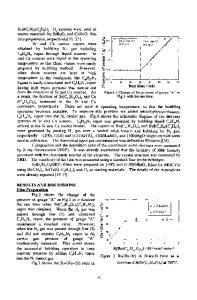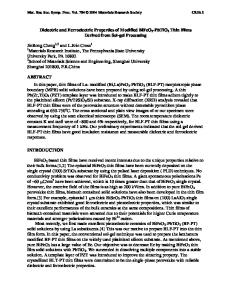Microstructure and ferroelectric properties of ultrathin PbTiO 3 films by MOCVD
- PDF / 429,745 Bytes
- 6 Pages / 612 x 792 pts (letter) Page_size
- 96 Downloads / 354 Views
0902-T03-31.1
Microstructure and ferroelectric properties of ultrathin PbTiO3 films by MOCVD H. Fujisawa, T. Horii, Y. Takashima, M. Shimizu, Y. Kotaka 1 and K. Honda 1 Department of Electrical Engineering and Computer Sciences, Graduate School of Engineering, University of Hyogo, 2167 Shosha, Himeji, Hyogo 671-2201, Japan 1 Fujitsu Laboratory Ltd., 10-1 Morinosato-Wakamiya, Atsugi, Kanagawa 243-0197, Japan ABSTRACT We report on microstructure and ferroelectric properties of ultrathin PbTiO3 films epitaxially grown on SrTiO3(100), La-doped SrTiO3(100) and SrRuO3/SrTiO3(100) by MOCVD. High angle annular dark field scanning transmission electron microscopy, atomic force microscopy, x-ray diffraction and x-ray reflectivity measurements demonstrated that 1-20 monolayer (ML)-thick epitaxial PbTiO3 films had high-crystallinity, atomically flat surface and sharp interface at an atomic scale. The epitaxial relationship and thickness were also confirmed by these methods. Kelvin force probe microscopy and contact resonance piezoresponse force microscopy revealed that a 7ML (2.7nm)-thick PbTiO3 film grown on SrRuO3/SrTiO3 had the ferroelectric polarization. INTRODUCTION The critical thickness in ferroelectric thin films has long been studied from the viewpoint of not only finite size effects but also non-volatile memory applications [1-13]. Recent theoretical studies have predicted stable ferroelectric polarizations in PbTiO3 films with several unit cells [10-13]. Experimentally, on the other hand, the presence of ferroelectric stripe domains was proved in 1.2nm-thick PbTiO3 films by synchrotron x-ray study. However, the thickness, in which polarization reversals by an external field were successfully observed, appears to be larger than ~10 monolayer (ML) (4nm) [2, 8, 9]. This may be due to an increase in leakage and/or a decrease in ferroelectric signal. In addition, the measurement and definition of thickness, composition, microstructure and crystallinity will be more and more important and difficult as the thickness decreases to several monolayers. Therefore, both high-quality samples and highly sensitive measurement techniques are required to investigate ferroelectricity in ultrathin films with a thickness below 4nm. In our previous study [6], we reported on the epitaxial growth of high-quality Pb(Zr,Ti)O3 films on SrRuO3/SrTiO3(100) by metalorganic chemical vapor deposition (MOCVD) and observations of ferroelectricity in 5- and 9-nm-thick Pb(Zr,Ti)O3 films by contact-resonance piezoresponse force microscopy (CR-PFM) which has higher sensitivity than that of conventional PFM [6, 14-16]. However, microstructure and ferroelectric properties in Pb(Zr,Ti)O3 films thinner than 5nm still remain unknown. In this study, we report on microstructure and ferroelectric properties of 1-20ML (0.4-8nm)-thick PbTiO3 films epitaxially grown on SrTiO3(100), La-doped SrTiO3(100) and SrRuO3/SrTiO3(100) substrates by MOCVD in more detail.
0902-T03-31.2
EXPERIMENTAL PROCEDURE SrTiO3 (STO) and La (1at%)-doped STO (La-STO) single crystals wer
Data Loading...










